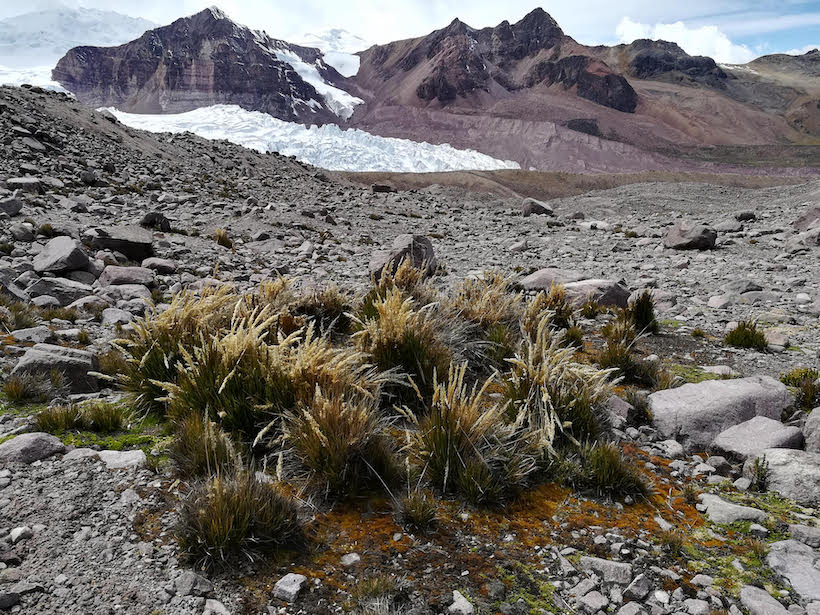A retreating glacier leaves behind a barren landscape, one that can be inhospitable to plants for decades. However, having excrement around—lots of it, preferably—can change that.
Dung contains nutrients like nitrogen and phosphorus that kick-start plant growth. Researchers working in the Andes have observed islands of vegetation nourished by animal excrement. These “dung gardens”—unstructured, unplanned patches of vegetation—might help plants move upslope in response to climate change, the team has suggested.
From Frogs to Dung
“They’re such striking features on the landscape.”
Kelsey Reider, an ecologist at James Madison University in Harrisonburg, Va., didn’t set out to study excrement. But in July 2018, fieldwork to investigate frog populations brought her to a recently deglaciated area in southeastern Peru. There, she happened to notice several patches of lush vegetation. “They’re such striking features on the landscape,” said Reider.
Reider and her colleague Steven Schmidt, a microbial ecologist at the University of Colorado Boulder, recognized these islands of vegetation as special. They’re made possible by vicuñas, a type of camelid native to the Andes, said Reider. “Imagine a very large, elegant-looking llama or alpaca with a long, slender neck.”

Vicuñas typically travel in groups of roughly five animals, and they deposit their excrement—masses of small, dark pellets—together in the same place. Think of a natural latrine, said Reider. “You get this accumulation of dung over time.”
An Infusion of Nutrients
As the organic material decomposes, nutrients like phosphorus and nitrogen leach into the ground. That injection of elements kick-starts plant growth in the otherwise barren, rocky environment, said Reider. “It’s really a nutrient limitation that’s delaying plant colonization and succession following glacial retreat.”
It can take upward of a century for vegetation to heavily colonize a high-mountain landscape, research has suggested. However, a pile of excrement can coax plants into existence far faster, said Reider. “We expect it to significantly shortcut the lag to plant colonization.”
The researchers observed dozens of dung gardens, each ranging in size from roughly 2 to 4 meters. The vegetation within them was varied and included tall, spiky grasses and low-slung mosses.
Grazing in the Garden
The team had a spare wildlife camera they didn’t need for their amphibian research, so they pointed it at one of the dung gardens. They captured visits from rodents, foxes, and vicuñas. Most tantalizing, they recorded 16 images of a vicuña grazing on the vegetation.
That’s surprising, said Julia Monk, an ecologist at Yale University in New Haven, Conn., not involved in the research. “It’s interesting to see that the increased vegetation growth really translates into herbivory.” A dung garden is bound to contain fecal parasites, which frequently deter animals, said Monk. “Animals often tend to avoid their own feces.”
This isn’t the first time, however, that vicuñas have been spotted grazing near their dung piles, said William Franklin, a wildlife ecologist at Iowa State University in Ames. “It’s been known for over 50 years.” Furthermore, it’s incorrect to think of these patches of vegetation as sustaining a vicuña diet, said Franklin. “They’re so small and so spread apart.”
Going Up to Get Cooler
“Latrines might be really important in the context of climate change.”
Despite their small sizes, these dung gardens might play an important role in the ecosystem, said Reider. They provide a literal toehold for vegetation high in the Andes, which might become increasingly important as plants are forced to shift upslope to cooler conditions to keep pace with climate change. “Latrines might be really important in the context of climate change,” said Reider.
Reider and Schmidt published their results in Ecology last year and hope to return to the Andes to continue to study these dung gardens. What plant species are populating these gardens and where their seeds come from are big questions, said Reider. “There’s a lot to do. We really want this pandemic to let us go back to Peru and continue this work.”
—Katherine Kornei (@KatherineKornei), Science Writer
Citation:
Kornei, K. (2021), Vicuña poop nourishes “dung gardens” high in the Andes, Eos, 102, https://doi.org/10.1029/2021EO156090. Published on 18 March 2021.
Text © 2021. The authors. CC BY-NC-ND 3.0
Except where otherwise noted, images are subject to copyright. Any reuse without express permission from the copyright owner is prohibited.

